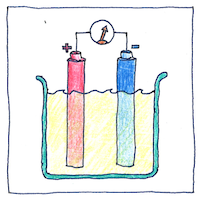Gaston Planté,
Camille Alphonse Faure
electromagnetism

|
Lead-acid battery
The oldest and most commmon rechargable battery is based on the lead-acid cell that Gaston Planté invented in 1859, and that Camille Alphonse Faure improved in 1881. Planté showed that lead sheets immersed in sulfuric acid could hold an electric charge, and Faure showed that a lead-sulfate coating worked better and was easier to mass-produce.
Other batteries
The lead-acid battery still dominates the automotive industry even after other battery technologies were adopted for other uses. The Leclanché cell was used in early telephones. The Columbia dry cell was used for flashlights. The nickel-cadmium battery was used in portable power tools. Today, lithium-ion batteries are used in cell phones and electric cars. Early disposable batteries were used elsewhere. The Bird’s cell was used in electrometalurgy. Callaud’s version of the Daniel cell was used in telegraph networks. The Grove cell was used in American telegraph networks. Electrotherapy quacks used the Pulvermacher chain. More battery types are in development or have not been widely adopted: molten-salt battery, nickel-metal hydride battery, flow battery, zinc-ion battery, lithium-air battery, glass battery, paper battery, sugar battery, and thin-film lithium-ion battery.
Everything’s a battery
If it stores energy as, according to Einstein, all matter does, as any living thing, animal or vegetable, retains and expends until its useful life is spent, let’s tune the parameters, try to make everything more efficient, lighter, more powerful, safer, more durable, cheaper, easier to maintain, and kinder on the environment.



There’s a difference between the potential energy “stored” in atoms and an electric charge stored in or generated by a battery; however, for the sake of noble goals it is good to consider energy sources as well as energy storage.
See also in The book of science:
Readings in wikipedia: